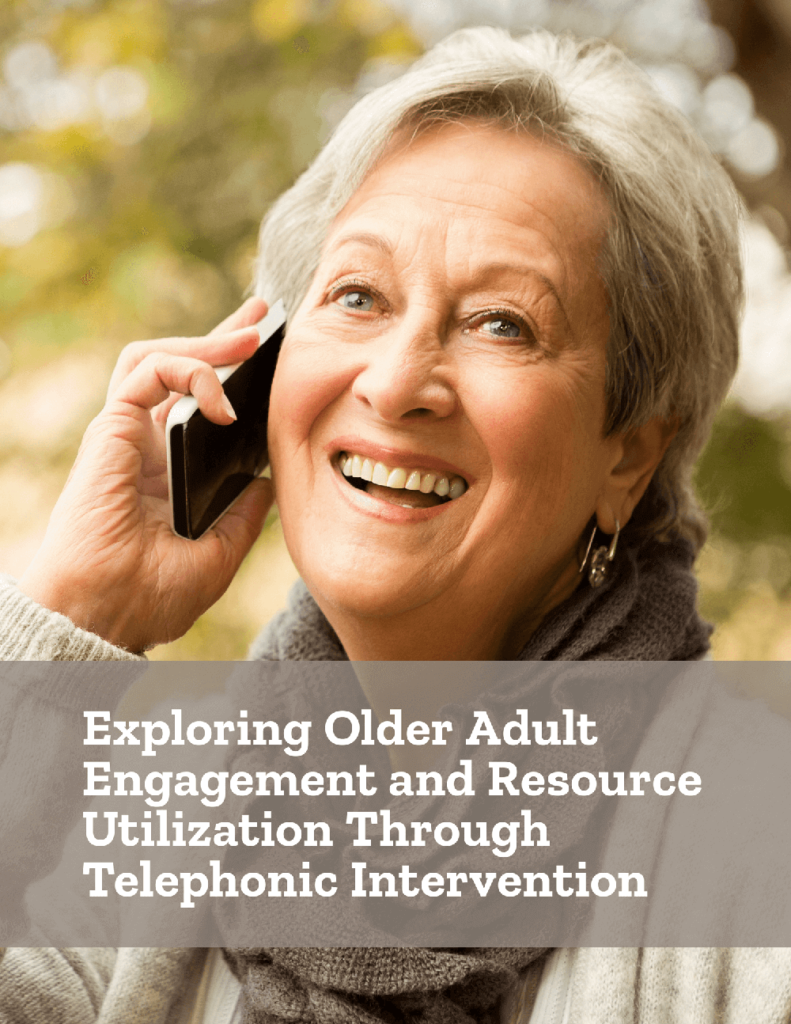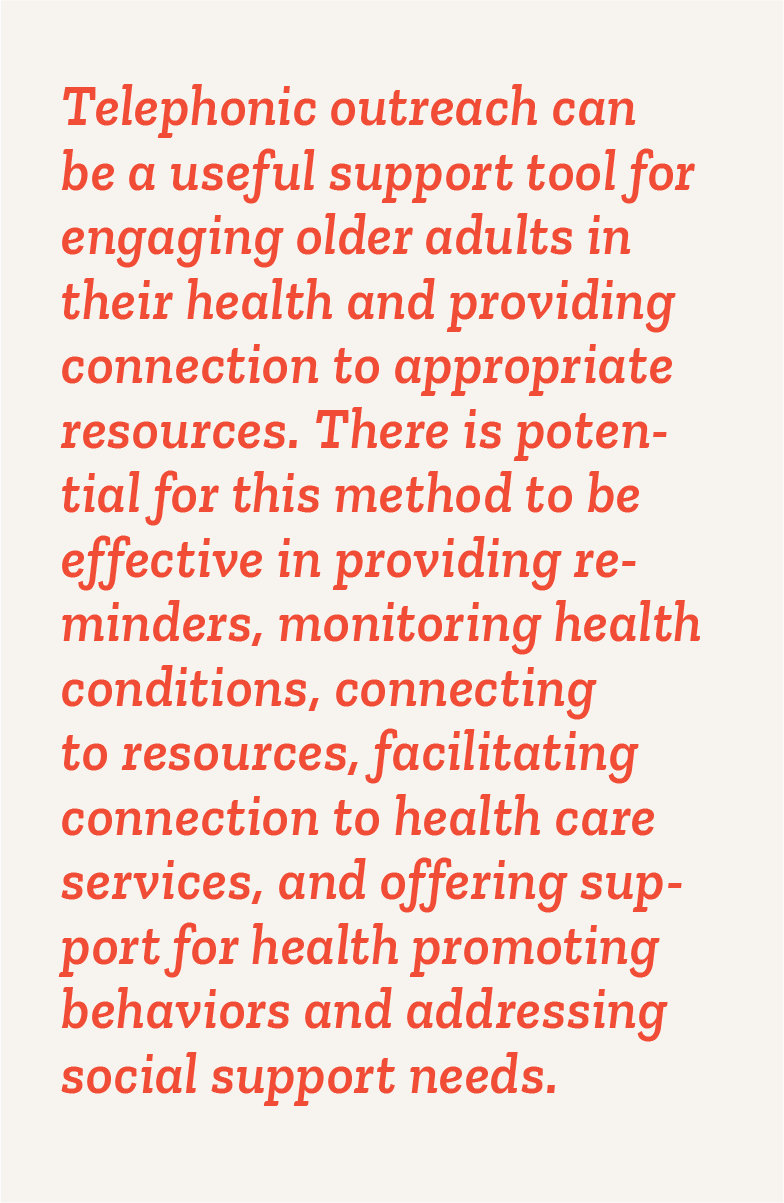
Executive Summary
- Many of the participants expressed concern around maintaining emotional wellness as they age.
- The emotional toll of caregiving is one of the most challenging components of this work.
- While physically and emotionally difficult, caregiving is a priority.

Background
According to the American Community Survey in 2021, there were estimated to be just under 1.9 million adults over the age of 60 in New York City and 1.37 million over the age of 65 [1]. This is roughly 22.4% and 16% of the population respectively [1, 2]. As individuals age, risk and prevalence of many chronic conditions increases [3]. Chronic conditions can significantly impact quality of life, ability to perform daily tasks, and increase the need for external support and health care services [3]. The impact of age on health aligns with the stark differences in health care utilization by age group. Adults over the age of 45 make up about 82% of the top 10% of healthcare utilizers in the United States, with those over 65 accounting for 45% and those between 45-64 accounting for 37% [4]. Managing chronic conditions, promoting healthy behaviors, and maintaining connections to preventative care services are all important factors in improving health outcomes and reducing overuse of healthcare services.
Telephonic interventions involve using phone calls to reach out to individuals to provide support and promote better health outcomes. Examples of programming that is well suited to this format include conducting needs assessments, care reminders, and providing connections to community services. This type of intervention has been employed with various populations to support chronic care management, promote healthy behaviors, and drive forward other health goals.
While telephonic interventions offer potential opportunities to drive positive health outcomes, more research is needed to understand how this intervention may be delivered and accepted differently across age groups. The existing literature on the efficacy and impact of telephonic interventions for older adults is still relatively small. Existing studies demonstrate that telephonic interventions may have a positive impact on managing certain health conditions and health metrics [5, 6, 7]. While this offers many benefits, potential barriers such as reaching the technologically underserved, acceptance of technology, and hearing challenges may limit the feasibility and equitable implementation of such programs within the older adult population have also been identified [8, 9].

Additionally, while many studies have looked at health outcomes, few have looked at engagement patterns, conducting assessments and resource referral. Understanding the viability of purely calling based interventions for older adults is critical to enhancing our ability to reach this population and support individuals in living healthy and happy lives. There is emerging research on the use and impact of app-based mobile interventions, but telephonic based interventions using calling as the primary form of contact may provide a better format for reaching older adults.
This white paper aims to contribute to the existing research and knowledge on telephonic interventions for older adults and how these can be used to engage older adults around needs assessments and resource connection. This white paper adds insights into how older adults engage with programs delivered through this modality.

Methodology
In partnership with AIRnyc and New York Network IPA, Vita Valens conducted a secondary analysis on the primary data collected from a community health worker intervention. The program provided health education and resource connection to New Yorkers participating in Medicaid. The community health workers provided health education and conducted several social care needs assessments on each individual.
The intervention period was January 2022 – December 2022, but the data collection period was June 2022 – December 2022. The data was collected and reported monthly. The monthly data was compiled and analyzed to assess rates of engagement of the older adults within the target population, identification of resource needs, and utilization of supportive services.
- Medical Expense Ratio of > 95%
- Total Spending on healthcare >$10,000
- Potentially Preventable Admissions > 1
- Healthy and Critical – under active treatment
- Health Home and HARP
A secondary target list was added during the program term to expand the target population to include individuals with social determinants of health needs. Outreach was continuously conducted throughout the entire data collection period and data was reported monthly until the end of the study. The assessments asked to individuals also changed during the study period to better meet the needs of the individuals contacted.
Data Cleaning and Analytics
Vita Valens utilized the available data to understand the efficacy of telephonic interventions on reaching and engaging an older adult population. The monthly data reports were combined, cleaned and analyzed to meet the aims of this research project. The data cleaning process included removing duplicate entries, systematizing formatting for analyses, and standardizing the needs assessments conducted across all months. Only data consistently collected across all months was included in the analysis.
The age of each participant was calculated as of June 1, 2022. This date was used to identify every individual who was 60 at the start of the data collection period (June, 2022). Additionally, the data collected varied slightly from month-to-month. To account for this, only data points that were collected across all months of the data collection period were included in this analysis. The data was analyzed to gain insight into how the older adult population within the targeted outreach group interacted with this telephonic intervention.
Of the initial target population identified for outreach (n=709), just under 18% of the participants identified as eligible to be included and contacted were over the age of 60 (n=125). After data cleaning, data for 116 individuals was available and utilized for this analysis. Of the 116 individuals that had at least one completed call and data was collected on, 25% were calls to individuals over the age of 60 (n=29).
Key data collected from individuals 60+ can be seen in summary tables below.
60+ participants (N= 29) Social Needs Indicated
|
Social Need Reported |
|
|---|---|
|
Number |
13 |
|
Percent (of the 60+) |
45% |

60+ participants (N= 29) Social Needs Indicated
|
Food |
Housing |
Financial Assistance |
Employment |
medical services or equipment |
Transportation |
|
|---|---|---|---|---|---|---|
|
# with |
9 |
2 |
5 |
1 |
2 |
1 |
|
% with identified |
69% |
15% |
38% |
8% |
15% |
8% |
60+ participants (N= 29) Connection to Health Care Support
|
Questions for a doctor I can help with? |
Help connecting with a provider/PCP? |
|
|---|---|---|
|
Number |
3 |
2 |
|
Percent (of the 60+) |
10% |
7% |
Discussion
This white paper shares insights from a research study on engagement of older adults in a telephonic intervention aimed at conducting needs assessments and connecting individuals to necessary resources. While 18% of the outreach population was over the age of 60, 25% of those meaningfully engaged in the program were 60+. This indicates that this population may be able to be well reached over the phone and possibly even more willing to connect through this method of communication than other age groups. This is a key area for additional studies as it can provide insight into the importance of understanding the target audience when designing and implementing programs.
Additionally, it was noted that many of the older adults engaged through this intervention were willing to share needs to be connected to resources over the phone. This points to the potential use for telephonic engagement around social care needs. Finally, only a few participants requested support from the community health workers when it came to connecting them to care. More studies on this are needed with larger sample sizes and more consistent data collection. Vita Valens also is considering whether building trusted relationships could support more utilization of supportive services of this kind.
Telephonic outreach can be a useful support tool for engaging older adults in their health and providing connection to appropriate resources. There is potential for this method to be effective in providing reminders, monitoring health conditions, connecting to resources, facilitating connection to health care services, and offering support for health promoting behaviors and addressing social support needs. It may also be useful for addressing concerns or questions that older adults may have about their health.
The data and this study had many limitations. One limitation of this project is that the data collected was not always consistent across the entire study period. As mentioned previously, the target population changed during the study to add more individuals eligible to participate, and the assessments completed with the participants shifted during the study as well. Additionally, this study employed self reported data, which may introduce biases. Finally, the sample size is relatively small and the population targeted is not generalizable to the general public.

Conclusion
The aging population is growing rapidly, and older adults face a range of challenges that can affect wellbeing and quality of life. Challenges can include social isolation, reduced mobility, and declining health. In response to these challenges, services have emerged to support older adults both within the home and externally to age meaningfully.
As the older adult population continues to grow, the need for services increases as well. Effectively reaching older adults can also be challenging particularly for those with limited mobility and resources. Other barriers such as lack of awareness, difficulty navigating complex systems, and stigma associated with aging can prevent older adults from accessing the services they need. Telephonic interventions have emerged as a promising solution to increase the availability and accessibility of services for this population. This white paper was created to contribute to the conversation around understanding how this age group interacts with telephonic programming.
This white paper also emphasizes the importance of developing interventions that are appropriately designed for the intended population. Engaging with older adults should take into account their unique needs and preferences. Personalized approaches should include assessments to identify their needs, preferences and barriers to accessing care. Successful engagement of older adults should include building trust and rapport, providing education and resources, fostering social connections, and involving family and caregivers when appropriate.
Given the existing research and the outcomes from this study, Vita Valens has begun a larger scale study to understand more fully how older adults engage with interventions over the phone and how best to build programs that can meet the unique needs and preferences of this population. Further research is needed to understand whether building trusted relationships adds benefit to such services and other techniques to address barriers and maximize benefit to the population being served.

- https://data.census.gov/table?q=S0101&g=160XX00US3651000
- https://www.nyc.gov/assets/doh/downloads/pdf/episrv/2019-older-adult-health.pdf
- https://www.ncoa.org/article/get-the-facts-onhealthy-aging
- https://www.ncbi.nlm.nih.gov/pmc/articles/PMC4946167/
- https://www.ncbi.nlm.nih.gov/pmc/articles/PMC7084843/
- https://onlinelibrary.wiley.com/doi/full/10.1111/opn.12398
- https://www.researchgate.net/publication/353639726_Effectiveness_of_a_telephone_intervention_based_on_motivational_health_coaching_for_improving_the_mental_health_of_caregivers_of_people_with_dementia_A_randomised_controlled_trial
- https://www.ncbi.nlm.nih.gov/pmc/articles/PMC8728775/
- https://www.sciencedirect.com/science/article/abs/pii/S0378512218300501







